Sea Buckthorn – Identification, Edibility, Distribution, Ecology, Recipes
Hippophae rhamnoides
Related posts:
- Recipe: Sea buckthorn and apple chutney
- Recipe: Wild Whisky Sour, with sea buckthorn juice and birch sap syrup
- Edibility – 4/5 – I would give them a 5, but some are likely to find their acidity too much, and some people find there is something in the smell that reminds them of baby sick! Its mostly about their berries and juice, but the leaves also make a decent, healthy tea, either fresh, or lightly fermented in the same way as rosebay willow herb leaves.
- Identification – 4/5 – A large shrub or occasionally more like a small tree. The bright orange berries are very distinctive, as are the shimmering silvery leaves, which are elongated oval in shape.
- Distribution – 4/5– Abundant (occasionally considered invasive) where established. I only know of a few scattered locations around Dumfries and Galloway, but there is tons of the stuff in other coastal areas.
- Season – Fruits mature around September, often persisting on the tree well into the next year.
- Habitat – Mostly coastal, or inland on sandy soils, dune edges etc. Now being planted on embankments, in gardens etc.
- Ecology – Sea buckthorn is dioecious, with separate male and female plants. The male produces brownish flowers which produce wind-distributed pollen. The female plants produce the orange berries that foragers seek. I have a few fruitless locations around Galloway where only one sex is present, poor lonely things. The roots distribute rapidly and extensively, fixing nitrogen in surrounding soils. It has been deliberately introduced to stabilise coastal soils, but in some areas of the UK it is now considered a problematic non-native invasive, crowding out native plants. However, it is extremely useful for humans, as well as supporting diverse insect communities and, through its abundant fruits, provides a good source of food for wintering thrushes as they arrive from the continent in the autumn.
This is the most striking and delicious of all our UK berries in my opinion – once you get over their nose-scrunching acidity! They are exceptionally good for you, being rammed with antioxidants and vitamin C. They are mostly found coastally, but are starting to be introduced – or introducing themselves – to more inland locations. As you recalibrate your senses to the sharpness, you should be able to enjoy the wonderful vibrancy of the flavour – which gets the whole mouth dancing…especially if you chew a hogweed seed at the same time!
The berries look like the easiest harvest you could imagine, but are essentially fragile balloons, desperate to squirt their acidic innards in your eye at the merest touch.
Sea buckthorn aficionados fall into 2 camps: milkers and freezers. Milkers don souwesters, goggles and very thick gloves and “milk” the berried twigs into buckets. Freezers (like me) selectively prune the best twigs, take them home, freeze them, then collect the berries cleanly and easily. If done mindfully, spreading your pruning around, this has negligible effect on the plant or ecosystem – in fact it often improves growth. Some people and organisations at some locations, consider sea buckthorn to be a problem invasive, so you may well be thanked for vigorously pruning it.
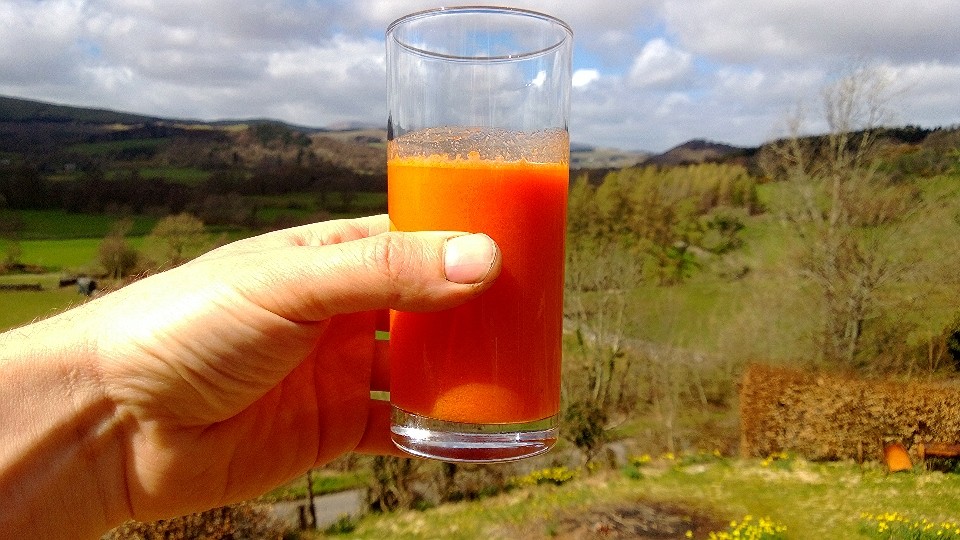
Not just colour sympathy – sea buckthorn juice with carrot juice is one of the finest, tastiest health drinks. Add a squirt of hogweed seed bitters to really set it off.
Its always entertaining to look back over old blogs. I wrote this in a very early instalment of my wild food journey. I haven’t found much more in Galloway since then, but have become quite adapt at incorporating visits to sea buckthorn-heavy bits of coast when i’m scooting about the country.
Chefs often pair sea buckthorn with white and dark chocolate in desserts. The berries make an excellent jelly with crab apples and a judicious amount of sugar, and also a tasty chutney.
There are a great many claims for the health benefits of sea buckthorn, but most are currently lacking in sound corroborative research. It does seem likely however that it can promote health in some or all of the following ways (Note: Sea buckthorn is usually taken medicinally as an oil extract of the berries, seeds and (occasionally) leaves. This has the effect of concentrating its beneficial constituents, but you can still gain these by including sea buckthorn berries and juice in your regular diet):
- Sea buckthorn is rich in various vitamins and minerals, as well as antioxidants and other plant compounds potentially beneficial to your health.
- Sea buckthorn oil may aid your heart by reducing blood pressure, improving blood cholesterol levels and protecting against blood clots. That said, effects may be strongest in people with poor heart health.
- Sea buckthorn may help improve insulin secretion and insulin sensitivity, both of which could protect against type 2 diabetes — though more research is needed.
- Sea buckthorn oil may help your skin heal from wounds, sunburns, frostbite and bedsores. It may also promote elasticity and protect against dryness.
- Sea buckthorn is rich in beneficial plant compounds such as flavonoids and antioxidants, which may help your body fight infections.
Read more about these and more potential benefits of sea buckthorn here.
Remember, there are no miracle foods, and good health is best supported by biodiverse eating. I like to juice sea buckthorn berries and drink them – 50/50 with carrot juice if i’m feeling healthy, or in a wild whisky sour more likely…
- Recipe: Sea buckthorn and apple chutney
- Recipe: Wild Whisky Sour, with sea buckthorn juice and birch sap syrup
- Edible wild fungi guide
- Edible wild plant guide
- wild foods in season now
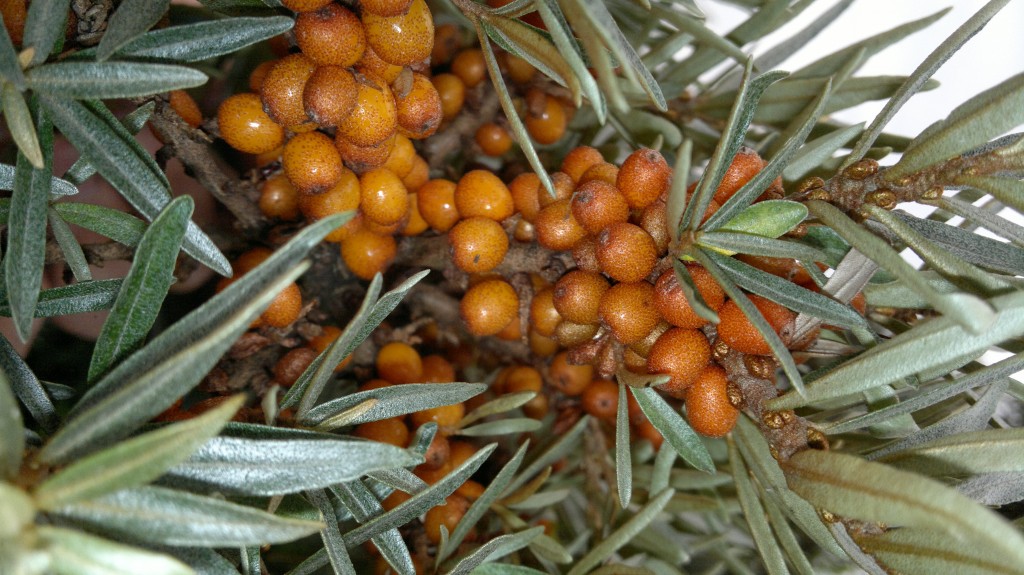
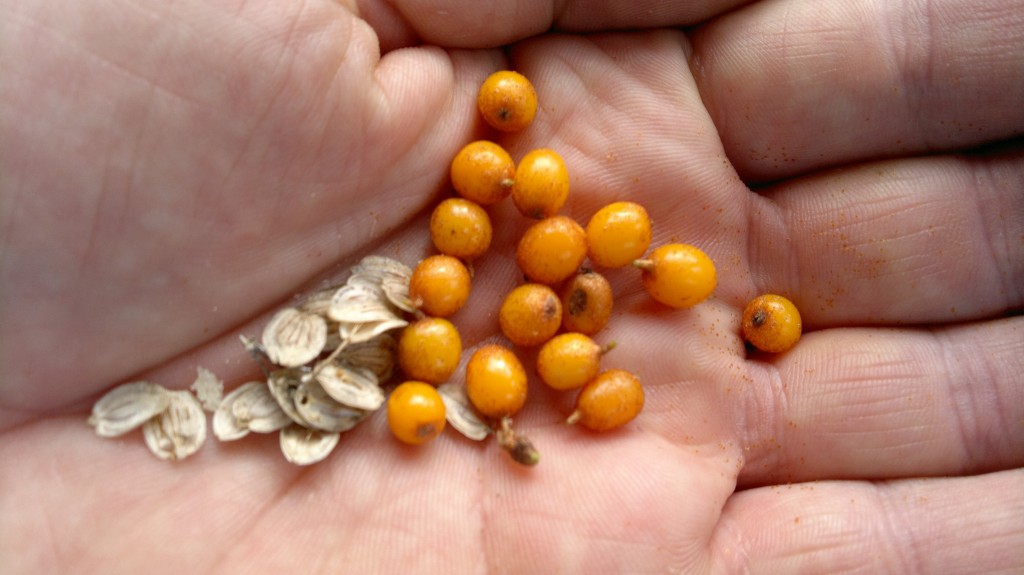
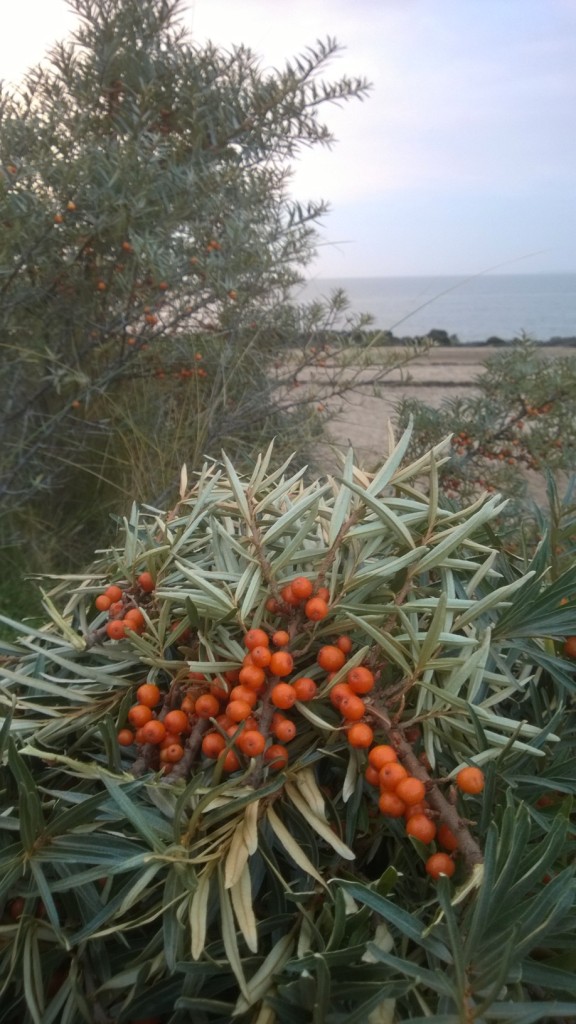
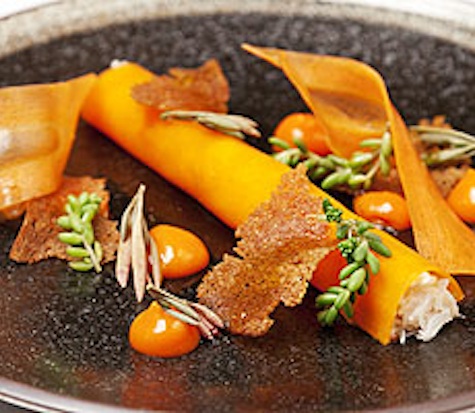

18 Comments
I once spent a weekend clearing sea buckthorn from Merthyr Mawr dunes, to the south of Bridgend in the Vale of Glamorgan, where it’s considered an invasive species. It wasn’t until years later that I realised that the berries were edible (no-one on the BTCV weekend had mentioned this) when I came across Sea Buckthorn icecream, in Harlech.
Mmmmm….buckthorn ice cream! I’m going to make some of this for sure. 🙂
Hi there, I just made my first batch of Elderberry vinegar and it’s wonderful!!!!!!!!!!!!!
I was wondering if you could achieve similar results with sea buckthorn. What do you think ????
Hi Kenneth,
Glad you like it! Sure, have a go with SB. It is much more acidic and i’m not sure the flavour would work in the same way – but you never know until you try – could be amazing!
Do let me know,
Cheers
Mark
i’m a twiddler. no pruning needed, and no squidging. But it IS slow…
THe seeds propagate well and I’m considering importing to my Shetland garden. Might it be a terribly mistake???!!
BEAUTIFUL shrub. Looks like a boreal relative of rosemary and olive and bay 🙂
ps have you got a good recipe for elderflower champagne? most of the recipes I see are for cordial. which is all very well, but….
Yes, on this site – type it into the search box
How can I grow it in my garden.
I am a forager, not a gardener! 😉
Info on cultivation here though:
Have seen what very much looks like buckthorn in my local park which is inland, nowhere near the sea. Only thing that puts me off trying is that I don’t see evidence of the thorns on the bush. Is this usual? Are there lookalikes out there?
Some variants are less thorny than others. I’m not aware of any other plants that share the elongated silvery leaves and bright orange fruits clinging to twigs. There is plenty of SB inland, even though it does best coastally.
I think this is not sea buckthorn, might be a cotoneaster. I remember being gobsmacked at seeing a row of the most abundantly laden sea buckthorns (I thought) I’d ever seen, when on a jaunt along the Leeds canal. When I got closer I realised the berries and branching structure were very similar, but the leaves were different. I tried a berry and it was very powdery, with no tang (cotoneasters are mildly toxic but are generally so unpalatable that poisonings are very rare), so defs was not SB. I think with no thorns at all it can’t be SB.
I’m interested in using wild foods in my cooking. I’m a chef and I want to implement some tasty wild seasonal pickings into my dishes.
Any advice on how you can tell if the berries have gone off. I froze a box full almost a year ago, have defrosted them but not sure if they are ok…researched the freezing method (after I did mine) and it was completely different to how I did it. Help please…before I have to throw them away!
If they have been frozen all year, I doubt they will have spoiled. The acid content is so high that they keep well even unfrozen. But only you can decide if you are comfortable using them. I would!
I sit in a church yard a lunchtime and I’ve been wondering what these beautiful berries along the hedgerow are for weeks! I would have never of thought of buckthorn in Shoreditch! Time for urban foraging I think…..
Very interesting .
I love this! Sea buckthorn has always fascinated me—not just for its vibrant color, but for the incredible flavor and health boost it provides. I’ve tried both juicing it with carrot and making a wild whisky sour, and the tartness really wakes up your taste buds. Definitely a berry worth foraging for, even if it takes a bit of patience around the thorns!